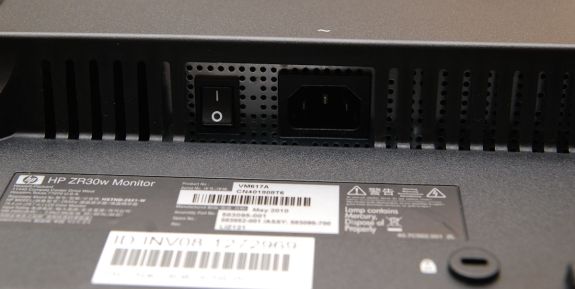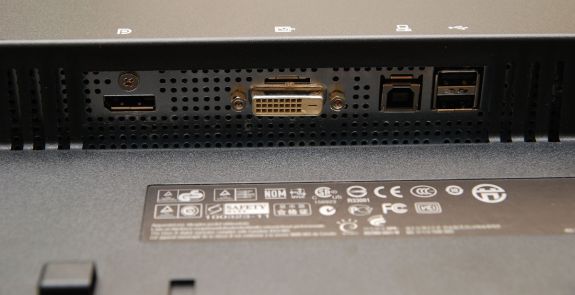A New 30" Contender: HP ZR30w Review
by Brian Klug on June 1, 2010 6:30 PM ESTThe LCD market continues to be one of the frequently updated segments in the consumer electronics segment, as OEMs and vendors alike are eager to bundle their high-end, high performance displays with professional workstations. The ZR30w belongs to that same pro market, offering a 10-bit panel with 1.07 billion colors - for an advertised 99 percent coverage of the AdobeRGB 1998 gamut and 30-bit per pixel color. HP claims that the ZR30w is the first 30" display to break 1 billion colors. When you’re selling a 30” LCD to enthusiasts, every bit of performance matters, and as we’ll show in a bit, the ZR30w doesn’t fail to impress.
As already noted, the ZR30w is targeted primarily at enthusiasts and professionals who demand accurate color tracking and equally large gamut. As with all 30” displays, every detail counts, as this segment represents generally the best of the best for manufacturers. It makes sense, too, since enthusiasts and professionals alike who are serious about getting the absolute largest in display real-estate also care about color tracking and gamut. They expect top performance, and are willing to pay for it. Though similar real-estate can almost be captured with arrays of smaller panels, for most, the 30” segment remains the most lust-worthy among displays thanks to the truly uninterrupted space.
The last 30” HP LCD we touched was the venerable HP LP3065 back in 2007. The LP3065 is still available today as well at $1,349 on HP’s website. The ZR30w is being introduced at a price point of $1,299 - some $300 below Dell’s UltraSharp 3008WFP display. Interestingly enough, the ZR30w does away with the plethora of DVI-D ports we praised the LP3065 for having (almost doubling as a KVM switch). It trims down the 3 DVI-D ports in the LP3065 to 1 DVI-D port and a DisplayPort for the ZR30w. That’s not a deal breaker, but you’re still one input shorter a generation later, which is a bit puzzling. Considering other 30” displays include a plethora of input options, we find the ZR30’s a bit spartan - an HDMI port or component would be welcome additions.
Before we go any further though, let’s dive into the specifications:
| HP ZR30w - Specifications | |||
| Property | Quoted Specification | ||
| Video Inputs | DVI-D, DisplayPort (both with HDCP) | ||
| Panel Type | S-IPS/H2-IPS (CN401808T6 unknown manufacturer) | ||
| Pixel Pitch | 0.250 mm | ||
| Colors | 1.07 billion colors (30 bits) | ||
| Brightness | 370 nits typical | ||
| Contrast Ratio | 1000:1 normal, 3000:1 (dynamic) | ||
| Response Time | 7ms (g2g), 12ms (on to off) | ||
| Viewable Size | 29.7" Diagonal | ||
| Resolution | 2560x1600 (WQXGA) | ||
| Viewing Angle | 178 degrees horizontal and vertical | ||
| Power Consumption (operation) | <130 watts typical, <185 watts maximum | ||
| Power Consumption (standby) | <2 watts sleep | ||
| Screen Treatment | Matte (anti-glare) | ||
| Height-Adjustable | Yes: 4" of travel | ||
| Tilt | Yes: -5 degrees to 35 degrees | ||
| Pivot | No | ||
| Swivel | Yes: -45 degrees to 45 degrees | ||
| VESA Wall Mounting | Yes - 100x100mm | ||
| Dimensions w/ Base (WxHxD) | 27.3" x 19.3" - 23.3" x 10.8" | ||
| Weight w/o Stand | 28.6 lbs | ||
| Additional Features | Integrated 4-port USB hub, HP Quick Release, optional speaker bar | ||
| Limited Warranty | 3 years parts, labor, and onsite service | ||
| Accessories | DVI-D, DisplayPort, USB, and Power Cables | ||
| Price | $1,299.00 | ||
We’ve already talked about the ports, but in case you haven’t used a 30” or equally high resolution panel before, note that dual link DVI is an absolute must. Luckily, HP ships a dual link DVI cable (I’ve seen a few monitors that require dual link DVI actually ship without dual link cables, which always results in a few nightmares) and makes note of it in the instruction manual.
Just don’t expect passive DisplayPort to DVI adapters or other single link DVI interfaces to drive the ZR30w; it won’t work. I experimented with a single link connection just for fun, and the ZR30w refused to show an image. There’s nothing wrong with that, it’s entirely expected. Just be sure you check your cables if things aren’t making sense.

There’s also an internal 4-port USB 2.0 hub. Two ports on the left side of the monitor, two on the bottom near the display inputs. Alongside the standard power connector is a power switch - been a long time since I’ve seen one of those on a monitor.












95 Comments
View All Comments
MamiyaOtaru - Wednesday, June 2, 2010 - link
are they always s-ips? I love my lp2065, but I had to find one that was advertised specifically as s-ips since not all of them were D:Teemax - Wednesday, June 2, 2010 - link
Excellent review! I appreciate the efforts in measuring the input lag!Looks like my Dell 3007WFP finally has a worthy replacement.
Mr Perfect - Wednesday, June 2, 2010 - link
Yes, I'm glad to see it compared to a CRT rather then a "good enough" LCD with unknown input lag.Earballs - Wednesday, June 2, 2010 - link
I guess I have to assume it's 60Hz?Earballs - Wednesday, June 2, 2010 - link
redacted.melgross - Wednesday, June 2, 2010 - link
I've given up on the idea of moving to 30" from 24". I use my monitors mostly for Photoshop, video editing, publishing, etc. I've found that even IPS displays of various types show a change in brightness and contrast in the sides from sitting at the distance required for this work. Because of the large size, you're always looking at the edges at an angle that will make the difference noticeable.I've been looking at the new 27" displays for that reason. Apple's new 27" iMac doesn't have as much of a problem because of the slightly smaller size, but with the LED backlighting, they only claim an sRGB gamut. It's pretty good, but not for what I need.
Is the NEC on your to do list? I hope so. The Dell 2711 hasn't proven to be all that great.
omf - Wednesday, June 2, 2010 - link
Thanks for the detailed review! It seems rare to get good, technical data in reviews these days...I'm surprised you haven't included tests for the Dell 3008 display, though. I've heard mixed things about it and would love to see some test results.
Thanks again!
R4F43LZiN - Wednesday, June 2, 2010 - link
I would like to see a full "how to calibrate your display" one of those days here on AT. I mean, there are a few of those on the internet, but none with the kind of detail and technical aspects that we've come to expect from a AT article.MauveCloud - Wednesday, June 2, 2010 - link
"Considering other 30” displays include a plethora of input options"From my research of 2560x1600 monitors, only the Gateway XHD3000 (which I use now, though I had to get it repaired a couple of weeks ago - I did the research on possible replacements) and the Dell 3008WFP have component inputs, or are you referring to 30 inch televisions, with native resolution 1920x1080, rather than 2560x1600?.
"The ZR30w has no OSD. If you recall, neither did its predecessor, the HP LP3065. At that time, HP claimed there were no ICs that could drive an OSD at native 2560x1600 resolution. Apparently this is still the case."
My Gateway XHD3000 has an OSD at 2560x1600 (albeit not fullscreen), and so does the Dell UltraSharp 3008WFP.
phoible_123 - Wednesday, June 2, 2010 - link
I've used this cable to connect a macbook pro to my 23" NEC monitor with Displayport:http://www.buy.com/prod/mini-displayport-to-displa...
It actually transmits sound as well if the monitor has an integrated speaker.